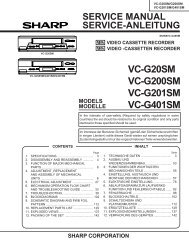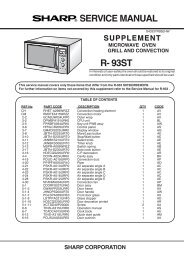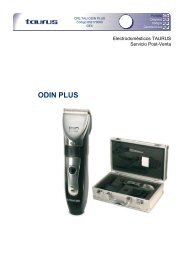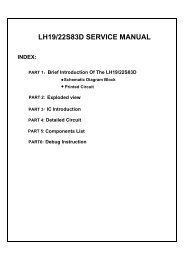Create successful ePaper yourself
Turn your PDF publications into a flip-book with our unique Google optimized e-Paper software.
SAW filters<br />
Ref. Standard Features<br />
K3953M B/G - D/K - I - L/L’ - IF filter for video application<br />
- TV IF filter with Nyquist slopes at 33.9 MHz and<br />
38.9 MHz<br />
- Constant group delay<br />
K9650M B/G - D/K - I - L/L’ - IF filter for audio application<br />
- TV IF audio filter with two channels<br />
- Channel 1 (L’ ) with one pass band for sound<br />
carrier at 40.40 MHz<br />
- Channel 2 ( L, D/K, I, B/G) with one pass band for<br />
sound carriers between 32.40 MHz and 33.40 MHz<br />
5-2-3 Tuner-and VIF-AGC<br />
At Pin 8, the VIF-AGC charges/discharges the AGC capacitor to generate a control Voltage for setting the gain of the<br />
VIF amplifier and tuner in order to keep the video output signal at a constant level. Therefore, in the case of all<br />
negative modulated signals (e.g., B/G standard) the sync. level of the demodulated video signal is the criterion for a<br />
fast charge/discharge of the AGC capacitor. For positive modulation (e.g., L standard) the peak white level of video<br />
signal controls the charge current. In order to reduce reaction time for positive modulation, where a large time constant<br />
is needed, an additional black level detector controls the discharge current in the event of decreasing VIF input signal.<br />
The control voltage (AGC voltage at Pin 8) is transferred to an internal control signal, and is fed to the tuner AGC to<br />
generate the tuner AGC current at Pin 11 (open collector output). The take over point of the tuner AGC can be adjusted<br />
at Pin 10 by a potentiometer or an external dc voltage (from interface circuit or microprocessor).<br />
5-2-4 FPLL, VCO and AFC<br />
The FPLL circuit (frequency phase locked loop) consists of a frequency and phase detector to generate the control<br />
voltage for the VCO tuning. In locked mode, the VCO is controlled by the phase detector and in unlocked mode,<br />
the frequency detector is superimposed. The VCO operates with an external resonance circuit (L and C parallel) and is<br />
controlled by internal varicaps. The VCO control voltage is also converted to a current and represents the AFC output<br />
signal at Pin 22. At the AFC switch (Pin 19) three operating conditions of the AFC are possible:<br />
AFC curve “rising” or “falling” and AFC “off”. A practicable VCO alignment of the external coil is the adjustment to<br />
zero AFC output current at Pin 22. At center frequency the AFC output current is equal to zero. Furthermore, at Pin<br />
14, the VCO center frequency can be switched for setting to the required L’ value (L’ standard). The optional<br />
potentiometer at Pin 26 allows an offset compensation of the VCO phase for improved sound quality (fine adjustment).<br />
Without a potentiometer (open circuit at Pin 26), this offset compensation is not active. The oscillator signal passes a<br />
phase shifter and supplies the in-phase signal (0 o ) and the quadrature signal (90 o ) of the generated picture carrier.<br />
- 41 -







